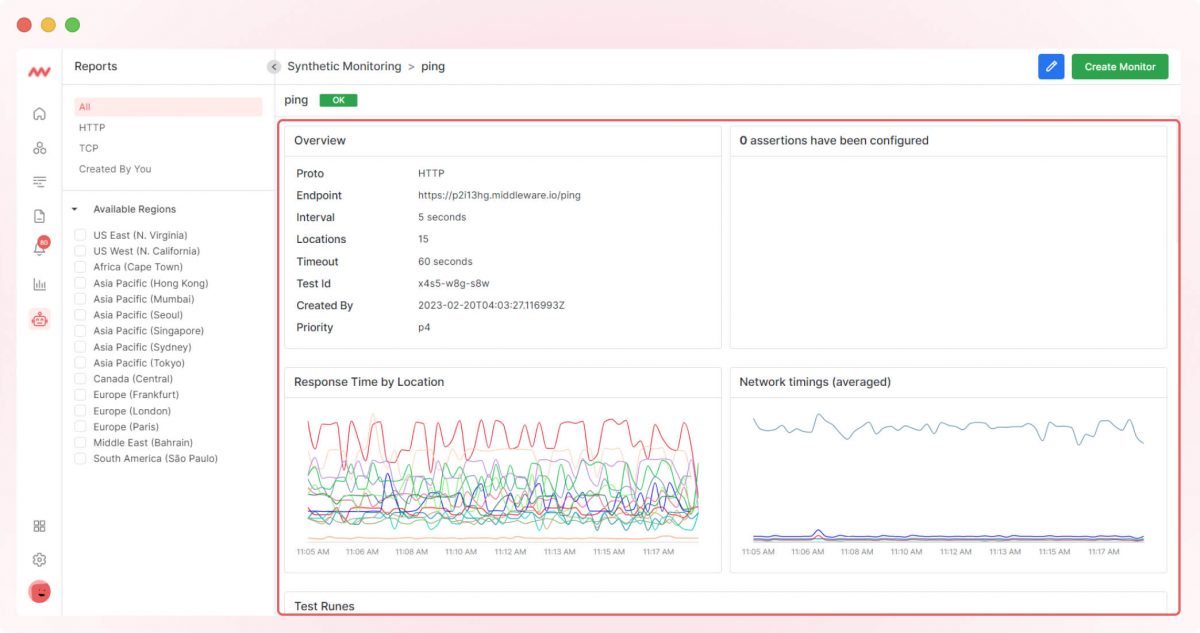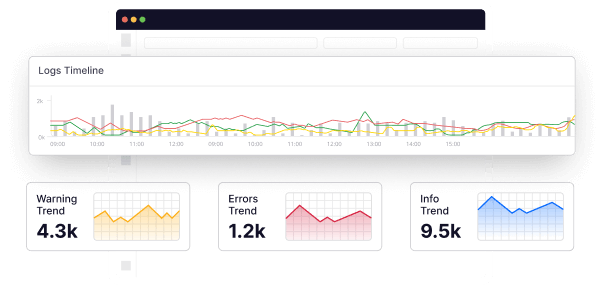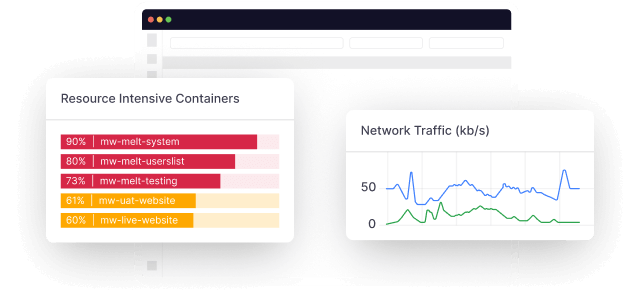Synthetic Monitoring and Real User Monitoring (RUM) are two approaches for monitoring and analyzing web performance. Synthetic Monitoring is a type of active monitoring tool, while Real User Monitoring (RUM) is a passive monitoring tool.
This article will delve into the features, use cases, and benefits of both RUM vs Synthetic Monitoring.
We will also examine how, despite having different uses and features, both monitoring tools can complement each other to deliver an exceptional user experience.
What is Synthetic Monitoring?
Synthetic Monitoring is an active monitoring method. It monitors the performance of a page in an artificial or ‘lab-like’ environment. This method simulates users and the path they might take through a website.
It mimics real user behavior by periodically executing predefined scripts or scenarios. The traffic detected using this tool is not from actual users. It is manually generated to monitor the performance of a website or application with a controlled set of variables (geography, network, device, etc.).

Synthetic Monitoring is mainly used to test websites and web applications before they go into production. These test results help establish a baseline performance. The baseline then aids in setting alert thresholds when the website or application goes live.
This active monitoring method also helps identify latencies and downtimes. It isolates and diagnoses the root cause of any performance issue that may arise.
Major benefits of using synthetic monitoring
1. Monitoring 24×7
Since the whole monitoring method is automated, it constantly tracks issues and bottlenecks. Even during off-hours. It provides the insights required to identify, isolate and resolve issues before they affect users.
2. Baseline and analyze performance
Baseline tests simulate how users might actually be using the website or application. These tests can monitor the key functions or processes of the website (e.g., test to create new profiles, test to complete a payment transaction, etc.). They can be carried out from different locations using various browsers and devices.
3. Benchmark against competitors
Synthetic Monitoring allows for monitoring any website or application. Since it does not need additional code, you can easily track your competitors’ websites and applications.
Their performance can then be used as a benchmark to assess your own site’s performance.
4. Test at every development stage
Synthetic Monitoring can be used to track applications at all stages of development. During the pre-production phase, it is used to identify potential issues that may hinder the application from going live.
Synthetic Monitoring is an important part of regression testing and production site monitoring. It is also used to baseline performance. Post-production, this baseline sets alerts for when the application or website may face issues.
5. Test complex processes’ performance
Checking for availability and uptime of your APIs is not enough for high-level performance. Synthetic Monitoring tools help in testing complex business processes and transactions from different locations. It also allows you to run side-by-side tests of various plugins and to see how they impact the site’s performance.
Drawbacks of Synthetic Monitoring
1. Too predictable
Synthetic Monitoring runs a known set of steps from a known location at regular intervals. This makes its performance predictable. It also makes it difficult to gauge what a real user may experience or how they may react to unpredictable variables.
2. Limited tools
You may not be able to integrate all existing tools with the monitoring scripts for your tests. Without a scriptless monitor creation tool, you may have to write new test scripts for each monitor.
3. Range of costs and features
The options available in the market are scarce. The cheaper options have barebone capabilities. While the ones with higher capabilities have a high price tag.
What is Real User Monitoring (RUM)?
Real User Monitoring (RUM) is a passive monitoring tool. It tracks performance data from real users accessing your website or application. It is also known as real user measurement and end-user experience monitoring.
Real User Monitoring is implemented by adding JavaScript tags to the application code. This script is activated when a user accesses the application. The script then captures performance metrics, such as availability, reachability, responsiveness, functionality, etc.
The captured data is then available on the RUM platform. On this platform, you can analyze the performance of your website or application and also understand real user behavior.
Real User Monitoring data offers insights into long-term trends. It can help you identify areas of the site that need optimization and focused attention.
Major benefits of using Real User Monitoring
Here are three major benefits of using RUM:
1. User-first approach
Analyzing page views, load times, page build performance, and a user’s browser/platform performance is crucial. It helps us understand how users are experiencing your website or application.
Real User Monitoring offers a granular view of user behavior. Real-time data collected from users helps make informed decisions to create a better user experience.
2. Faster actionable insights at the page and network level
RUM Platform’s alerting feature allows you to monitor the website’s user experience in real-time to get actionable insights. These insights can help the DevOps team identify problems at lower levels of a website.
After identification, the team can categorize and rank issues based on severity and frequency.
3. Captures a wide range of metrics
With Real User Monitoring, there is no need to pre-define important use cases. It captures all data as a user traverses through the website, irrespective of which pages they visit. This is especially helpful for large-scale websites or applications subject to frequent changes.
Drawbacks of Real User Monitoring
1. Requires real traffic
Real User Monitoring can be used in the pre-production phases, but it might not collect useful data. The ability to monitor, capture and analyze a user’s behavior makes sense only if generated from real user traffic.
2. No benchmarking capabilities
Real User Monitoring relies solely on user traffic to generate insights. Thus, there is no way to measure a website’s performance against a set benchmark. Since Synthetic Monitoring is run regularly, in intervals, it can easily compare against a set baseline.
3. High volume of data collection
Usually, accurate data is an advantage while maintaining a website. But the amount of data collected by the RUM platform is immense. Each user has their dataset every time they visit the website. This can often leave DevOps teams overwhelmed.
RUM vs. Synthetic monitoring: The differences

To better understand the distinctions between RUM vs. Synthetic Monitoring, let’s compare them based on their features, use cases, and benefits in the following table:
| Feature | RUM | Synthetic Monitoring |
| Monitoring scope | Captures actual user interactions | Simulates user interactions |
| Real-time data | Yes | No |
| User segmentation | Yes | No |
| Performance insights | Granular view of user experience | Overall application performance |
| Root cause analysis | Yes | Limited to predefined scripts/scenarios |
| Proactive alerting | Limited | Yes |
| Testing environment | Primarily in the production environment | Primarily in the staging environment |
| Impact on real users | Minimal | None |
| Scalability testing | Limited | Yes |
| Geographic coverage | Wide coverage | Controlled locations |
| Browser and device testing | Yes | Yes |
These are some of the major ways in which Real User Monitoring tools and Synthetic Monitoring tools differ. These factors also vary depending on the vendors and the purpose of the tools used.
Essentially, Real User Monitoring data provides a clearer understanding of performance. Thereby enabling you to eliminate performance issues. On the other hand, Synthetic Monitoring data ensures that the site properties and functions are performing optimally.
But, these tools need not be an either-or case. There are many ways in which they can perform together and complement each other’s features.
How Do RUM and Synthetic Monitoring Complement One Another?
A comprehensive monitoring solution harnesses the power of both tools. This solution is ideal for creating websites and applications that are fast, reachable, reliable, and customized to support a great user experience.
Here are a few examples to illustrate how RUM and Synthetic Monitoring complement each other in real-world scenarios:
1. Correlating Business with Performance
Real User Monitoring excels at providing visibility into the actual user experience. This helps businesses understand how application performance affects user behavior and how user behavior impacts their services.
On the other hand, synthetic monitoring enables organizations to establish performance benchmarks and verify whether the defined standards align with the real user experience.
By combining these approaches, businesses can validate the correlation between application performance (including user experience) and business metrics.
2. Identify Problems Before Active Users Arrive
Global websites and applications have users worldwide. This increases the cumulative load on the multiple website servers. Especially during local daytime or peak traffic hours.
This is why infrastructure maintenance is usually scheduled for off-peak hours (like at midnight local time).
During this off-peak maintenance, some unpredicted issues performance of the website or application. Ideally, this issue will need to be resolved before the live-user traffic increases.
Synthetic Monitoring enables DevOps teams to detect potential bottlenecks, assess their infrastructure’s scalability, and optimize critical functionalities’ performance. All before users begin using the application.
RUM provides insights into real user behavior. These insights allow businesses to identify performance degradation caused by unexpected usage patterns. By leveraging both approaches, organizations can address issues before active users are affected.
3. Testing Applications in a Staging Environment
As RUM data is collected in real-time, it cannot be used to assess the effectiveness of new features in a pre-production environment. In this case, Synthetic Monitoring is used during new features’ development and testing phases.
By simulating user interactions, synthetic tests can ensure that important workflows, such as user registration or checkout processes, are functioning properly.
The real-time insights of RUM data can then be used to simulate how users may approach a new feature. Thereby allowing for more detailed testing of new feature implementations.
4. Troubleshooting Outages
Troubleshooting becomes easier when both Synthetic Monitoring and Real User Monitoring are used. During the event of an application outage, both tools can leverage their features to diagnose and resolve the root cause.
Synthetic tests can detect failures in key functions, helping teams identify the root cause and initiate the troubleshooting process promptly. RUM complements this process by providing granular details about the impacted user segments, their geographical locations, and the specific user actions that experienced issues.
In Summary: Synthetic Monitoring vs. Real User Monitoring
Real User Monitoring (RUM) and Synthetic Monitoring are two powerful methods for monitoring the performance of applications and websites. RUM captures actual user interactions in real-time, providing valuable insights into user behavior and experience.
Synthetic Monitoring simulates user interactions and helps establish performance benchmarks. Rather than viewing them as competing approaches, organizations can benefit from leveraging both methods in a complementary manner.
By combining RUM and Synthetic Monitoring, businesses can comprehensively understand their application’s performance. They can proactively resolve issues and correlate business metrics with performance efficiently.
The synergy between these monitoring approaches enables organizations to deliver exceptional user experiences and meet performance targets.
By harmoniously leveraging the strengths of RUM and Synthetic Monitoring, organizations can create high-performing applications and delighted users.
FAQs:
What is the difference between RUM and synthetic testing?
The difference between RUM and synthetic testing lies in their approach to monitoring. RUM captures real user interactions in real-time, providing insights into actual user experiences.
On the other hand, synthetic testing simulates user interactions using predefined scripts. This allows organizations to monitor application performance before users access it.
What is the difference between synthetic monitoring and performance monitoring?
Synthetic monitoring focuses on simulating user behavior and monitoring predefined processes to assess overall application performance. Performance monitoring, on the other hand, encompasses a broader range of monitoring techniques.
These include synthetic monitoring, real user monitoring (RUM), and other methods. Performance monitoring gathers data and analyzes application performance from different perspectives.
What is the difference between synthetic monitoring and passive monitoring?
Synthetic monitoring actively simulates user actions and monitors processes to assess application performance.
Passive monitoring involves monitoring without simulating user interactions. It collects data passively, usually by analyzing network traffic or server logs.





